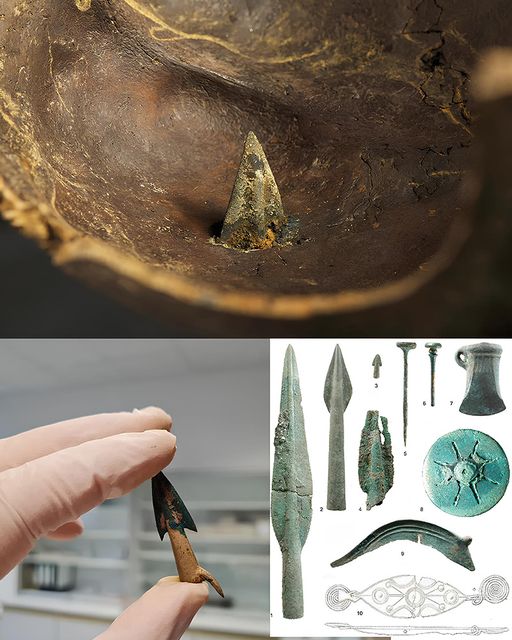The Tollense Valley in northern Germany has unveiled an archaeological treasure of immense historical importance: Europe’s oldest known battlefield, dating back an astonishing 3,250 years. This extraordinary discovery has not only reshaped our understanding of the Bronze Age but has also illuminated the violent struggles and sophisticated societies of ancient Europe. The site offers a vivid glimpse into a brutal chapter of history, shedding light on the complexities of human conflict during a transformative period.
It all began in 1996 when a lone human arm bone embedded with a flint arrowhead was found protruding from the riverbank of the Tollense River. What appeared to be a minor discovery at first quickly turned into one of the most significant archaeological finds in European history. Over the following decades, detailed excavations revealed a staggering array of evidence, including over 12,500 human bones from at least 140 individuals, 300 artifacts such as bronze and flint arrowheads, wooden clubs, and shield fragments, as well as the remains of horses, suggesting the presence of mounted warriors. The exceptional preservation of these relics, including weapons still embedded in skeletons, provides an unfiltered view of the sheer brutality that characterized Bronze Age warfare.

Unlike the small-scale skirmishes traditionally associated with this era, the evidence from Tollense points to a massive, organized battle. Forensic analysis of the remains reveals traumatic injuries such as crushed skulls, severed limbs, and punctured torsos, indicative of close-quarters combat fought with extraordinary savagery. Additionally, isotope analysis of the bones reveals that many of the warriors were not local to the area but had traveled great distances, potentially hundreds of kilometers, to fight. This suggests a conflict involving multiple communities or alliances. The strategic positioning of the battlefield along the Tollense River implies it may have served as a crucial chokepoint, ideal for controlling movement or valuable trade routes. Together, these findings challenge earlier assumptions of isolated Bronze Age communities, revealing instead a picture of extensive interaction, regional alliances, and large-scale military coordination.
The motivations behind this monumental conflict remain a subject of ongoing research, with several compelling theories emerging. One possibility is that the battle was fought over control of lucrative trade routes, as the Tollense Valley may have been part of a significant network linking northern Europe to the Mediterranean. This theory is supported by the discovery of exotic goods, such as amber, near the site. Another plausible explanation involves territorial disputes, where rival tribes or alliances clashed over land and resources. The presence of non-local fighters also hints at the possibility of coalitions breaking apart, leading to widespread violence. While the exact reasons for the conflict remain elusive, it is clear that the battlefield represents a level of political complexity not previously attributed to Bronze Age Europe.
The technological insights gained from the battlefield further enhance our understanding of the era. The preserved weaponry and skeletal remains reveal sophisticated craftsmanship and combat strategies. Bronze arrowheads found at the site indicate advanced metallurgical skills, while wooden shields and clubs point to a balance between offensive and defensive tactics. The discovery of horse remains suggests that cavalry units played a role in the battle, providing evidence of organized military forces and strategic planning. These findings highlight a society capable of both crafting high-quality weapons and mobilizing large-scale warfare, challenging long-held assumptions about the technological capabilities of Bronze Age communities.
The Tollense Valley battlefield’s legacy extends far beyond the artifacts unearthed. It compels us to rethink the social and political structures of Bronze Age societies, traditionally considered simple and insular. Instead, this discovery paints a picture of a dynamic and interconnected world where long-distance travel was common, complex alliances shaped regional dynamics, and large-scale warfare was not only possible but a defining aspect of life. The battle serves as a poignant reminder of humanity’s enduring struggle for survival and dominance, showcasing both the ambition and violence that have characterized human history for millennia.

This ancient battlefield, etched into the landscape of the Tollense Valley, offers an intimate look at a distant and brutal past. The stories written in the bones and artifacts reveal a world where resilience and resourcefulness were paramount, and survival came at a steep cost. As researchers continue to study the site, they are uncovering new layers of insight into the lives, struggles, and ambitions of our ancestors. These discoveries bring the Bronze Age into sharper focus, making it feel closer and more vividly human than ever before.
The Tollense Valley’s significance lies not just in its historical revelations but also in its ability to challenge our perceptions of ancient societies. By presenting a more nuanced and complex view of the past, it invites us to reconsider the sophistication of our ancestors. The battlefield’s well-preserved artifacts and skeletal remains serve as a powerful testament to the resilience of the human spirit and the relentless drive for survival that has defined human history. This groundbreaking discovery ensures that the stories of those who fought and perished in the Tollense Valley will continue to resonate for generations to come, offering invaluable lessons about the intricacies of human conflict and cooperation in a time long past.





